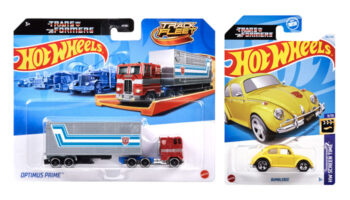Open 2 Design’s Matt Burtonwood on his creative process, taking breaks – and patting his back while kicking himself…

As the co-founder of Open 2 Design, Matt Burtonwood is the brains behind a number of popular products. Recently, he and his business partner began pitching their own ideas, including the much-celebrated Rubik’s Cage.
Matt, great to speak! I’m not sure why you and I haven’t done this before, but tell me: what’s your background ? How did you get in to toys and games??
I started out working in a more traditional product design role. I was an intern at Philips in the Netherlands, then went on to intern with a design consultancy in San Francisco called Astro Studios.
Looking at their site, they seem to do pretty slick stuff – stunning images…
Yes – and it was a fantastic experience! I was lucky enough to get a full-time position when I graduated. An amazing place to work: the fridge was always stocked with cold drinks and, once a week, we got great snacks to accompany staff meetings.
To be clear, when was this?
2001 – at the peak of the dot-com boom. Every design studio engaged in an arms race to have the coolest office. I worked with some really-talented designers and met a lot of people that we still work with today. Shortly after I came back to the UK to set up Open 2, one of my old directors took up a role within Disney Consumer Products helping them build a consumer electronics team. My dream as a kid was always to work at Disney and I hassled him on a regular basis to bring us in on some projects…

Eventually, he said yes and we worked on a line that accompanied the Toy Story 3 release. We also did some WALL-E items, and a range of Disney tech products. We then started working with a broader range of Disney teams: they introduced us to Disney license holders as a safe pair of hands to work on projects. That’s pretty much where it started. From then on, we started working more directly with toy companies, and looking for that kind of work.
And when you were younger, which were your favourite toys?
I think Transformers would have been it for me. I remember saving up to buy one – I paid in coins! One Christmas I put together a list of five or six that I really wanted – including Optimus Prime and Megatron. Unfortunately, I got one pretty-crappy one… I can’t even remember which one it was, but it was pretty tough to take.

You know, I’m sure there’s a book to be written about this… A number of people tell stories of these quiet, first-world tragedies! Like a friend of mine told me how, for three or four years – as a child – she pestered her impoverished mother for this wonderful pedal car in the toy shop. Then, one Christmas, my friend’s mother buy’s the pedal car! When my friend sits in it, she can’t fit her legs in! She’s hankered after it for so long, she’s physically outgrown it!
That is tragic!
And yet… We’re laughing! But there are lots of these moments where it’s not just a brief disappointment – it’s the annihilation of a dream…
I can see that from looking at my Transformer… I was a good kid; I felt pretty slighted by Father Christmas.
He’s always been fickle! Did you have other hobbies?
I was pretty hard into Nintendo. I completed Super Mario Bros 1-3, Mega Man 1 and 2, Kid Icarus. That amount of time alone in a dark room naturally led to teenage years collecting and painting citadel miniatures and roleplay gaming.

Did that help you later, do you think?
Yes. Well – I like to think that’s where some of my model-making skills were brought to the fore. I got into drawing cartoons too… I was a big fan of Gary Larson and the Far Side cartoons. I started sending my ideas to various magazines and got a few published. I have a great rejection letter from Willy Rushton at Private Eye.
Good Lord! I had no idea! You say a great rejection letter?
Put it this way: Willy Rushton was a fan of the stick rather than the carrot! But it worked… I got a few cartoons in Punch and it became a bit of a revenue stream to get me through university without having to do proper work.

Might be worth noting that Willie Rushton submitted cartoons to Punch – and got rejected. Just saying! So… Open 2 Design now offers itself out as work for hire, but also develops its own ideas. How do you split your time?
There’s not a conscious split. We’re still very much a work-for-hire company, and enjoy working with different companies… In the last couple of years, though, it’s been great to try pushing some of our own ideas and test them out in the real world.
That’s a recent thing? When did that start?
When we entered the Mojo pitch with Rubik’s a few years ago. We did that almost by chance… I think we met Billy Langsworthy by phone a few weeks prior through a client intro, so we did our best to clear out some time and try it. We pitched a bunch of ideas. One of those was Rubik’s Cage, which launched last year.
I didn’t realise that was your first time out. That’s extraordinary. One thing I found fascinating was that you pitched 10 to 15 images rather than prototypes. What’s the advantage of doing that?
It’s tricky… It’s always felt like it made sense to show a bunch of ideas rather than putting all your eggs in one basket with a more-thoroughly developed prototype… Because the reality is you’re always going to get more ideas passed over than picked up. So we see it as a numbers game, and it’s more cost effective to show presentation visuals than prototypes. There are some ideas that always benefit from a model, of course, and some ideas that makes sense to test as a prototype – card games for example.

Agreed. I think you rattled through more ideas than anyone else during that first Rubik’s event. It would’ve cost a LOT of money to prototype all of them…
Even now, though, I think we look at that meeting as a bit of a turning point for us. It gave us the confidence to take a few more chances, and we’ve really seen that come through in the last couple of years.
What changed in your thinking?
In the past, we’d often have an idea and wait a few months on it… Then we’d see something similar come to market and kick ourselves. But we’d also pat ourselves on the back because we were clearly on the right lines. We’ve moved on from that a bit now and look to push more things forward when the opportunity comes up.
You’re quite-rightly saying “our” and “we” because you don’t take on the world alone… You work with the terrific Ben Williams. How do you divide responsibilities?
Do you mean Mojo Nation Young Designer of the Year Ben Williams?!
I do! Has he now changed his name to that?
Yes, by deed poll! He still hasn’t brought his trophy into work though. We pretty much have the same skillset. Ben is more likely to work on things that need more thinking and patience. I tend to work more at the front end, causing problems that he has to fix. He’s fantastic at vehicles… To be honest he’s fantastic full stop.

In a previous interview, you told Billy that one has to “switch on” the brain “to be open to ideas”. How do you do actually do that, though? How do you start to – as you put it – “…think about everything, all of the time!”?
I’m not sure. I think confidence has a part in it. If you’re having a purple patch for ideas, you’re less likely to kill something in your head which allows it to develop into something, or feed into something else.
Just in case it’s not a well-known phrase, I’m going to define “purple patch” as a run of luck or success. So are you saying, “There are no bad ideas?”
No… No, it’s not quite, “there are no bad ideas” because clearly there are! Sometimes, though, you might have a bad idea that seeds something else, or you just forget about it and it pops up later as part of something else. So I think it’s about allowing things to sit around in your head long enough that eventually they turn into something good.
Great! That incubation is so important… It’s hard to put that across, I think. So if I were to ask you to walk us through your creative process, how step-by-step would it be?
It really depends on the type of project. Certainly, work-for-hire projects can be more methodical and step by step as there tends to be a pre-determined outcome. We know we’ll essentially follow a path from sketch to rendering, 3D model and prototype.

Your own ideas are less structured?
Yes… The pattern tends not to be as repeatable. It tends to start with Ben or me walking into the office, or texting the other to say, “I have an idea that’s going to be bigger than the internet”… Then we pitch each other to see if there’s any merit in taking it further. Then it makes it on the list for us to pick up at some point.
So just backing up – where does the initial spark come from?
The spark that starts the conversation? That can come from anywhere! When those ideas hit it can be a massive rush, it’s like one of those snowballs rolling down a hill in a cartoon gradually building momentum.
And what else helps?
So the process tends to be a random conversation that leads to a spark of an idea, which gets written down on my phone. I then discuss the idea at work or at home before it makes it on to the development list… When we get breaks in projects we then pick things up. And actually, I just bought some storage boxes to help archive projects. I got fed up with things being left unfinished… So the goal now is to complete more ideas and close the lid on the box. Then, when opportunities come around, we have things ready to open up. It kind of works like that.

When you work from a brief, what restrictions routinely prove useful?
A price point. Style guides. A deadline.
You find the pressure of a deadline helps?
Definitely. If you don’t have the push and the discipline nothing happens… But the flip side of that is being prepared to walk away and change it up if it’s not flowing. If the ideas aren’t coming, walk away. You can spend hours noodling an idea and not getting anywhere, but if you walk away and come back the next morning you’ll fix it in five minutes.
Great! Great advice. I think sleeping on things is hugely important – but taking a shorter break works for you too, presumably?
Yes! And true to our dot-com routes, we also have a table-football table in the office. Games last a good 15 minutes; that allows for the drinks to brew and our brain fog to lift. I always say if it feels like you don’t have time for a break, you need the break even more.

That’s quite profound. Might just type that up as an image! So if you were asked to write your autobiography, what would you call it?
Bigger than the Internet
Love it! Finally, then – and inevitably – what’s the most interesting thing in your office or on your desk?
This one is easy. Have you seen the film Caddyshack? Do you know the gopher?
I have and I do… Long before a groundhog was Bill Murray’s on-screen nemesis, so too was a gopher!
Right! Well, we have a full-size, animated, dancing gopher. It came from a charity shop in the States… It dances to the Kenny Loggins song, ‘I’m Alright’ from the Caddyshack soundtrack.
Brilliant! I don’t know where we’d stand on broadcasting rights but maybe we’ll post a video of that. Sounds great! Matt Burtonwood, thank you so much.
—-
To stay in the loop with the latest news, interviews and features from the world of toy and game design, sign up to our weekly newsletter here























